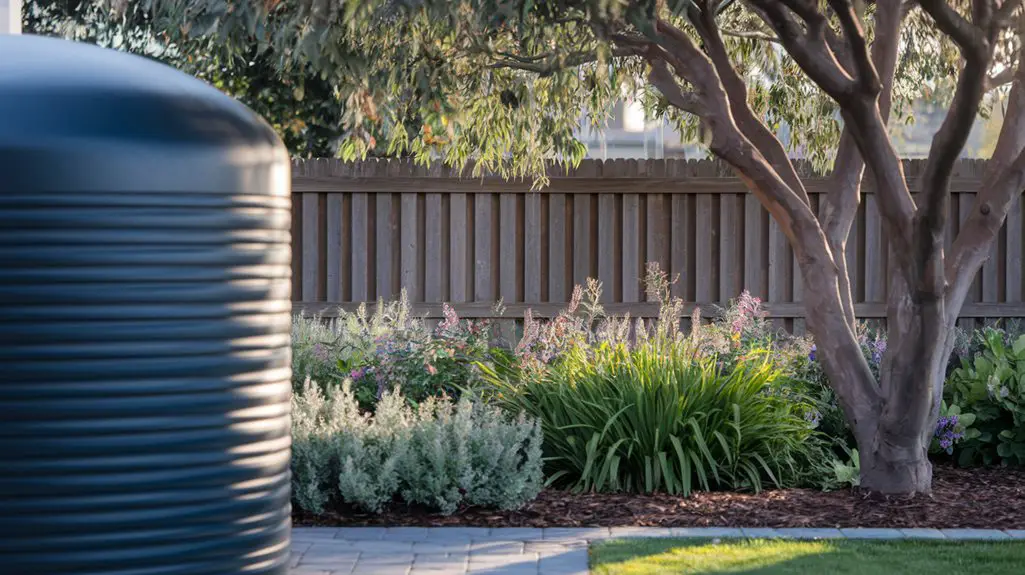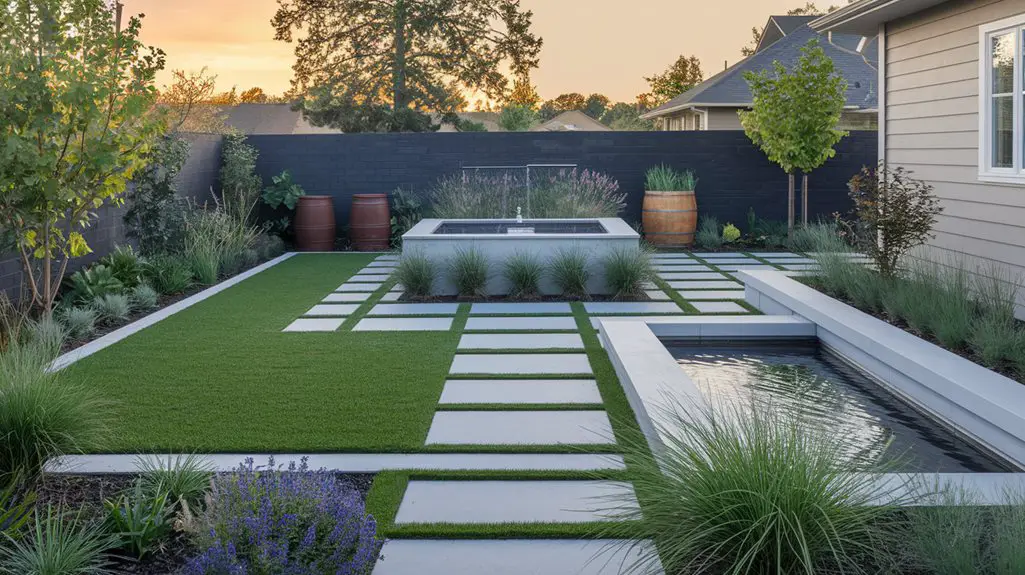Like Poseidon harnessing the power of the seas, you too can master the seasonal rhythms of rainwater for your garden’s benefit. You’ll discover that each season offers unique opportunities and challenges for rainwater collection. From winter preparation to summer conservation techniques, your approach must adapt throughout the year. The right seasonal strategy not only conserves water but dramatically improves plant health and reduces utility bills—all while protecting our most precious natural resource.
Winter Barrel Maintenance for Maximum Spring Collection
While many gardeners neglect their rain barrels during colder months, winter maintenance is essential for ensuring ideal collection when spring arrives.
Empty your barrels completely to prevent freezing damage, then rinse out sediment that’s accumulated during fall collection.
Inspect all seals, spigots, and connectors for cracks or leaks. Apply food-grade silicone lubricant to gaskets that show signs of drying.
Check downspout diverters and remove leaf debris that could block water flow.
If you live in severe winter regions, store cleaned barrels upside down in a sheltered location. For milder climates, installing insulation wraps can protect barrels left outdoors.
Don’t forget to disconnect hoses and leave spigots open to prevent pressure buildup. Implementing smart strategies for rainwater management will enhance your system’s efficiency.
Come spring, you’ll have fully functional collection systems ready to capture every valuable raindrop.
Spring Setup: Positioning Your Rainwater Collection System

As winter gives way to warmer temperatures, strategic positioning of your rain barrel system becomes critical for maximizing collection efficiency.
Evaluate your garden layout now before spring showers arrive, guaranteeing prime placement for both collection and distribution.
Position barrels with these proven strategies:
- Place collection points at downspout locations receiving the highest roof runoff volume
- Guarantee a minimum 2-foot elevation for gravity-fed pressure to garden zones
- Shield barrels from direct afternoon sun to prevent algae growth
- Install on level, reinforced surfaces that can support barrel weight when full (500+ pounds)
Consider accessibility for maintenance and your regular watering routines.
Multi-barrel systems should connect with overflow mechanisms directing excess water to secondary collection points or designated drainage areas. Additionally, utilizing rainwater systems can significantly reduce water bills and enhance garden sustainability.
Summer Irrigation Techniques Using Stored Rainwater

The scorching summer months present unique challenges for efficient garden irrigation using your harvested rainwater.
Implement drip irrigation systems to deliver water directly to root zones, reducing evaporation by up to 60%. Connect your rain barrels to soaker hoses using gravity feed for beds farthest from collection points.
Water deeply but infrequently—once or twice weekly is ideal for most plants, encouraging deeper root growth.
Apply mulch around plants to retain moisture and extend intervals between watering sessions. For container gardens, use reservoir pots or ollas buried in soil to provide slow-release hydration.
Monitor soil moisture using a simple finger test or moisture meter before watering.
Prioritize edible crops and new plantings when supplies run low.
Consider automated timers for early morning irrigation when evaporation rates are lowest. Regularly inspect your system for maintenance issues to ensure optimal performance and efficiency.
Fall Preparations: Cleaning Gutters for Efficient Collection
Fall’s arrival signals the critical time to prepare your rainwater harvesting system for maximum collection efficiency during upcoming wet seasons. Accumulated debris in gutters can reduce collection capacity by up to 40% and introduce contaminants to your stored water.
Clean your collection system thoroughly by:
- Removing all leaves, twigs, and sediment from gutters and downspouts
- Checking for and sealing leaks at gutter joints with appropriate silicone sealant
- Installing or cleaning gutter guards to prevent future blockages
- Testing downspout connections to verify proper water flow into collection barrels
Complete this maintenance before the first heavy rainfall to maximize your harvest potential. Additionally, ensuring your system is well-maintained can significantly enhance rainwater collection efficiency and lead to better drought resilience.
You’ll secure cleaner water for spring gardens and prevent overflow damage to foundations during winter storms.
Best Container Options for Different Garden Sizes
Selecting appropriate rainwater storage containers directly impacts your garden’s irrigation potential and system efficiency.
For small urban gardens (under 100 sq ft), consider 50-100 gallon barrels or slim-profile tanks that maximize vertical space while minimizing footprint.
Medium gardens (100-500 sq ft) benefit from 200-500 gallon polyethylene tanks or interconnected barrel systems that can be expanded as needed. These provide sufficient capacity for weekly watering during dry spells.
Large gardens (over 500 sq ft) require substantial storage—1,000+ gallon cisterns or underground collection systems offer the volume needed for consistent irrigation.
Look for UV-resistant, food-grade materials with proper overflow valves, mosquito screens, and child-safe lids.
Remember that every 1,000 sq ft of roof area can collect approximately 625 gallons from just one inch of rainfall. Additionally, rainwater collection barrels are a popular option for efficient storage solutions in residential setups.
DIY Rainwater Filtration Systems for Chemical-Free Gardens
While commercial filtration systems offer convenience, building your own rainwater filter delivers superior customization at a fraction of the cost.
Your harvested rainwater contains atmospheric pollutants, roof particles, and organic matter that require filtration before garden application.
Construct your three-stage filtration setup using these essential components:
- First-flush diverter to redirect initial rainfall containing highest contaminant concentration
- Mesh screen (50-100 micron) to capture leaves, twigs, and large particulates
- Activated carbon layer to absorb chemical impurities and improve water clarity
- Bio-filter section with small stones and beneficial bacteria to neutralize harmful microorganisms
Position your DIY system between collection and storage vessels.
Replace filter media seasonally to maintain efficiency.
This configuration removes up to 90% of contaminants while preserving beneficial minerals your plants need for robust growth.
Connecting Multiple Barrels for Expanded Storage Capacity
As your garden’s water demands increase, a single rain barrel often proves insufficient for reliable season-long irrigation. Connecting multiple barrels creates a scalable system that maximizes capture during heavy rainfall events.
Install barrels in series using overflow ports with 1″ bulkhead fittings and flexible PVC connectors. Position your primary collection barrel at the highest point, allowing gravity to fill subsequent containers. Verify each barrel sits on level, stable platforms that can support 500+ pounds when full.
For maximum efficiency, install ball valves between connections to isolate individual barrels for maintenance without emptying the entire system. Additionally, using multiple rain barrels can significantly enhance your water harvesting capacity, especially during peak rainy seasons.
For extensive gardens, consider linking four or more 55-gallon drums to create 220+ gallon capacity. This configuration provides approximately 10 days of irrigation for a 1,000 square foot garden during peak summer growing periods.
Smart Technology Integration for Automated Garden Watering
Once your multi-barrel collection system is established, modern technology can revolutionize how you manage and distribute this valuable resource. Smart controllers connected to weather sensors allow precise irrigation based on real-time conditions, conserving water while optimizing plant health.
- WiFi-enabled flow meters track your harvested rainwater usage, preventing waste and providing valuable consumption data.
- Solar-powered distribution pumps guarantee sustainable operation even during power outages.
- Moisture sensors embedded in soil zones trigger watering only when plants truly need hydration.
- Smartphone apps let you monitor and adjust your system remotely, providing peace of mind during vacations.
Additionally, implementing innovative rainwater systems can enhance the efficiency of your garden watering setup. Install check valves and mesh filters to prevent backflow contamination and clogging. Most systems can be retrofitted to existing setups with minimal plumbing modifications.
Legal Considerations and Permits for Harvesting Systems
Before installing any rainwater harvesting system, you’ll need to navigate the regulatory landscape that varies considerably by location. Many municipalities require permits for systems exceeding certain capacities, typically 500-5,000 gallons.
Check your local building codes and water rights laws, as some states restrict collection methods or total volume. Contact your local environmental agency to verify compliance with health regulations, particularly if you’re planning to use harvested water for edible gardens.
Most jurisdictions mandate backflow prevention devices to protect municipal water supplies from contamination. Some areas offer tax incentives or rebates for approved systems that meet ecological standards.
Document your system’s specifications, including capacity, filtration methods, and overflow provisions. This documentation will streamline the permit application process and demonstrate your commitment to responsible water management.
Conclusion
You’ll find that implementing these seasonal harvesting techniques transforms your garden’s resilience. Like a well-designed watershed that captures 90% of available precipitation, your system will maximize nature’s bounty while minimizing municipal water usage. Don’t wait for drought conditions to establish your collection infrastructure—start today. With proper maintenance and strategic deployment across seasons, you’re not just gardening; you’re creating a sustainable water management system that pays dividends for years.



